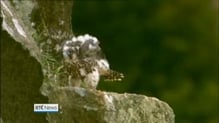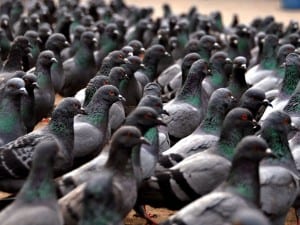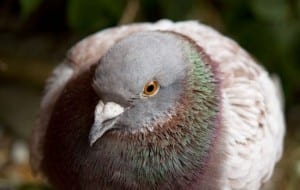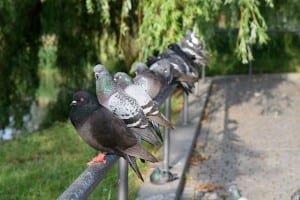
by Pigeon Patrol | Jul 16, 2015 | 4-S Gel Bird repellent, Animal Deterrent Products, Bird Deterrent Products, Bird Netting, Pigeon Patrol's Services, Pigeon Spikes, UltraSonic Bird Control
 The leader of an anti-pigeon petition in Deal is appealing for help to make feeding the creatures an offence.
The leader of an anti-pigeon petition in Deal is appealing for help to make feeding the creatures an offence.
Sean Gabb, of Middle Street, and his neighbour Emma Lee have already called on Dover District Council to take swift and effective action to reduce the number of pigeons in Deal, by sending a petition with more than 200 signatures.
Dr Gabb attended Deal Town Council’s monthly meeting on Tuesday, June 23 to ask for councillors’ support in his bid.
Dr Gabb wants it to be an offence to feed pigeons
He asked them to use their powers to make it a littering offence to feed pigeons, under the district council’s new Public Spaces Protection Order.
This would put Deal in line with towns such as Swansea and Bolton.
Dr Gabb was supported by chairman of the Chamber of Trade, Peter Jull, who is keen to protect the buildings in the town.
Deal businesses who have already shown their backing include Merrygardens, CJ Howe, Hawkins Menswear, No Name Shop and Dunlin & Diver.
Councillors unanimously voted in favour of having the subject on the agenda of the next full council meeting on Monday, July 20 where they will be able to discuss the issue in full and decide on any action.
Cllr Ben Bano said: “I very much support this going on our agenda and to make it meaningful I think we should invite a senior environmental officer and the portfolio holder for public health to attend the meeting.”
About Pigeon Patrol:
Pigeon Patrol Products & Services is the leading manufacturer and distributor of bird deterrent (control) products in Canada. Pigeon Patrol products have solved pest bird problems in industrial, commercial, and residential settings since 2000, by using safe and humane bird deterrents with only bird and animal friendly solutions. At Pigeon Patrol, we manufacture and offer a variety of bird deterrents, ranging from Ultra-flex Bird Spikes with UV protection, Bird Netting, 4-S Gel and the best Ultrasonic and audible sound devices on the market today.
Voted Best Canadian wholesaler for Bird Deterrent products four years in a row.
Contact Info: 1- 877– 4– NO-BIRD (www.pigeonpatrol.ca)

by Pigeon Patrol | Jul 10, 2015 | 4-S Gel Bird repellent, Bird Deterrent Products, Bird Netting, Pigeon Patrol's Services, Pigeon Spikes, UltraSonic Bird Control
 Alderman Bill Wilson said the biggest problem areas where pigeons have been congregating are being experienced by Devonport’s eating houses.
Alderman Bill Wilson said the biggest problem areas where pigeons have been congregating are being experienced by Devonport’s eating houses.
He said retail outlets and other building owners in the central business district had complained about the problem as well.
“The pigeons do make an evil mess,” he said.
Alderman Wilson tabled a successful notice of motion at Monday night’s council meeting, calling for a report in relation to the health concerns related to pigeons in the CBD and whether measures were needed to eradicate them.
Sales manager at Banjo’s Bakery and Cafe in the mall, Jannene Langmaid, said yesterday that feral pigeons invading the cafe were an issue and the birds had been getting worse in recent weeks.
“We have to shoo pigeons away from coming inside the door about every 10 minutes,” she said.
“We can’t shut the door because it locks on the outside.”
Alderman Wilson told Monday night’s council meeting that he knew the pigeons were a real nuisance but he didn’t know if they were also a health concern.
Alderman Wilson said an owner of several buildings in Devonport told him that he’d had a quote to make one of his building’s pigeon proof and it was going to cost $3500 to prevent the pigeons from nesting and resting.

by Pigeon Patrol | Jul 9, 2015 | 4-S Gel Bird repellent, Animal Deterrent Products, Bird Deterrent Products, Bird Netting, Pigeon Patrol's Services, Pigeon Spikes, Pigeons in the News, UltraSonic Bird Control
BirdWatch Ireland has said it is “horrified” by what appears to have been a deliberate attempt to poison peregrine falcons nesting in Dalkey Quarry in Co Dublin.
The birds, a protected species, are nesting on a ledge in the quarry and have four chicks nearly ready to fledge.
The incident came to light last week after a walker noticed two tethered pigeons flapping near the nest.
The pigeons’ wings had been clipped to stop them flying and they had what is described as a “wet substance” on their neck.
Peregrines eat live prey and would have been attracted to the pigeons by their wing flapping as they attempted to escape their tethers.
The pigeons have been submitted to the State laboratories for testing.
The National Parks and Wildlife Service said the falcons are facing “a significant threat” and “it is likely that further attempts may be made to interfere with the birds”.
It is calling on the public who use the area to remain vigilant and report any similar incidents.
It also warned that people should keep children and pets away from suspect birds as these poisons are harmful to wildlife, domestic animals and humans.
Minister for Arts, Heritage and the Gaeltacht Jimmy Deenihan said: “It is not tolerable for these majestic and extraordinary birds of prey or any other wildlife to be persecuted or poisoned.
“It is illegal, but just as important; it harms our reputation as a country that values its wildlife.
“I would urge anyone to report such incidents to the National Parks and Wildlife Service in my Department. Harming our birds is not acceptable.”
About Pigeon Patrol:
Pigeon Patrol Products & Services is the leading manufacturer and distributor of bird deterrent (control) products in Canada. Pigeon Patrol products have solved pest bird problems in industrial, commercial, and residential settings since 2000, by using safe and humane bird deterrents with only bird and animal friendly solutions. At Pigeon Patrol, we manufacture and offer a variety of bird deterrents, ranging from Ultra-flex Bird Spikes with UV protection, Bird Netting, 4-S Gel and the best Ultrasonic and audible sound devices on the market today.
Voted Best Canadian wholesaler for Bird Deterrent products four years in a row.
Contact Info: 1- 877– 4– NO-BIRD (www.pigeonpatrol.ca)

by Pigeon Patrol | Mar 19, 2015 | Animal Deterrent Products, Bird Deterrent Products, Bird Netting, Pigeon Spikes, Pigeons in the News, UltraSonic Bird Control
 Residents of Fairbanks, Alaska, are sounding the alarm bells over a surge in guano that’s threatening to consume their city. According to reports, the local pigeon population has exploded in recent years, leaving people reeling from their inescapable excrement.
Residents of Fairbanks, Alaska, are sounding the alarm bells over a surge in guano that’s threatening to consume their city. According to reports, the local pigeon population has exploded in recent years, leaving people reeling from their inescapable excrement.
“It’s Poopsville,” says architect David Whitmore, whose downtown building alone is home to 20 different nests belonging to the pesky, prolific birds.
Producing up to 25 pounds of poop apiece each year, the pigeons are damaging dozens of properties and relentlessly terrorizing townspeople. Roofers recently discovered a 6-inch layer of pigeon poop spackled atop the historic Courthouse Square building. Meanwhile, property owners scramble just to keep the pigeon poop in check, the Fairbanks Daily News-Miner reports.
Twice a year, employees at a downtown parking garage must don Tyvek suits and respirators to scrape 75 gallons of guano from the structure’s concrete floors. They then must dispose of the droppings in the hazardous materials section of the area landfill.
“Pigeon crap weighs a ton,” says Marcus Dodge, executive director of the Fairbanks Parking Authority. “It’s not a lot of fun to clean up.”
Probably not. But folks in Fairbanks should expect to get down and dirty with bird waste far into the future, according to wildlife authorities. “Pigeons are pretty darn flexible,” says Cathie Harms, a spokeswoman for the Alaska Department of Fish and Game. “They will eat a variety of food. They are prolific breeders.”
Unfortunately for some, that reality has yet to sink in.
 “They’re a hazard to the equipment. They’re a hazard to people,” says Robert Franklin, a maintenance foreman in town. “They get into stuff they are not supposed to.”
“They’re a hazard to the equipment. They’re a hazard to people,” says Robert Franklin, a maintenance foreman in town. “They get into stuff they are not supposed to.”
About Pigeon Patrol:
Pigeon Patrol Products & Services is the leading manufacturer and distributor of bird deterrent (control) products in Canada. Pigeon Patrol products have solved pest bird problems in industrial, commercial, and residential settings since 2000, by using safe and humane bird deterrents with only bird and animal friendly solutions. At Pigeon Patrol, we manufacture and offer a variety of bird deterrents, ranging from Ultra-flex Bird Spikes with UV protection, Bird Netting, 4-S Gel and the best Ultrasonic and audible sound devices on the market today.
Voted Best Canadian wholesaler for Bird Deterrent products four years in a row.
Contact Info: 1- 877– 4– NO-BIRD (www.pigeonpatrol.ca)

by Pigeon Patrol | Feb 26, 2015 | Animal Deterrent Products, Bird Deterrent Products, Bird Netting, Pigeon Patrol's Services, Pigeon Spikes, Pigeons in the News, UltraSonic Bird Control
Scarecrows have never worked, and history shows that advancements in technology haven’t worked much better when it comes to shooing birds away from ripening crops.
“You set out propane cannons, they’ll habituate. You broadcast predator calls, they’ll learn to ignore them. They’ll even get used to packs of angry wiener dogs,” said Mark Hinders. “About the only things that work to exclude birds are nets, guns and poison. But those are expensive and/or bad manners.”
Hinders, professor of applied science, and John Swaddle, professor of biology, are the core members of the Sonic Nets collaboration at William & Mary. The idea is to produce an effective, non-lethal bird deterrent, a solution to an age-old problem that is affordable, polite and does not rely on a steady supply of irritable dachshunds.
Instead of scaring or even alarming the birds, Sonic Nets works on the annoyance principle. As they dine in a farmer’s field, birds keep up a constant chatter. A device called a parametric array projects a narrow beam of sound to disrupt the birds’ field chatter, which seems to be mainly about the quality of the hors d’oeuvres and the immediate predator situation.
Like a noisy cocktail party
“It’s like the cocktail party problem,” Hinders explained. “You’re in a room and a lot of people are talking and it can be difficult to follow an individual conversation. It doesn’t even have to be especially loud. It’s just that all those other people’s words fill in the empty spaces. And so you go to a quiet room so that you can hear.”
The Sonic Nets collaboration has attracted considerable interest over the years, beginning in 2012, when the Bill and Melinda Gates Foundation named the project a Grand Challenges Explorations winner. Additional support from the Andrew W. Mellon Foundation allowed birdsong expert Dana Moseley to join the collaboration in fall, 2014 as a Mellon postdoctoral fellow.
There also has been considerable movement toward eventual commercialization of Sonic Nets, as well. The collaborators have been discussing options with a group of M.B.A. students at William & Mary’s Raymond A. Mason School of Business under the leadership of Richard Ash, executive director of the Mason School’s Alan B. Miller Center for Entrepreneurship. A patent application for the parametric array system is under consideration, and Sonic Nets has entered into a partnership with Midstream Technology, a Williamsburg firm, to pursue commercial opportunities.
The technology was first tested with starlings in William & Mary’s aviary. Those encouraging results led to a summer of field tests at Fort Eustis. Swaddle explained that the Fort Eustis tests included an examination of a completely different use for the parametric array—minimizing bird-aircraft collisions by chasing birds away from runways. The airfield work is funded by the Virginia Center for Innovative Technology.
“We surveyed bird activity at three places at the airfield four times a week for eight weeks,” Swaddle said. “The first four weeks gave us a baseline of bird activity. During the second four weeks, we deployed our Sonic Net at one of the sites—and recorded an approximate 85 percent reduction in the presence of birds in that area.”
Testing in an open field
The instrumentation shack (left) holds the white rectangular parametric array aimed at the elevated food tray.
They also field-tested the devices in an open field, with the action recorded on video. The video footage from the open-field tests is still being processed, but Swaddle said the airfield data exceeded their expectations. The aviary tests showed that the Sonic Nets reduced the presence of starlings at food by 50 percent. He suggested that the higher success rate at the airfield is probably due to the difference between wariness of wild birds versus captive starlings.
“After our aviary testing, we thought that we would see a stronger effect in the field, but not as strong as we recorded,” Swaddle said. “We think the Sonic Net works because birds can’t hear alarm calls or predators. In the aviary, there isn’t much threat. In the wild, there are plenty of threats and so there is greater need for birds to hear these calls.”
Bird vocalization is much more rich and diverse than calls to alert the flock to the presence of predators or food. Moseley’s Ph.D. research centered on how males use songs to attract potential mates as well as ward off rivals. The breeding-related vocalizations are yet another aspect of the deep aural avian experience.
“It’s interesting to think about how the world of birds is such an acoustic world,” Moseley said. “It can be hard for us to see some little brown bird in a bush. And it’s hard for them to see each other too in a bush or in a forest, or even in a field. The way that they are able to interact with their environment is especially through sound.”
‘Soundscape’ theory
The wide-frequency capabilities of the apparatus open up the potential for “tuning” the Sonic Nets sound to target particular species. Nonlinear acoustics principles incorporated into design of the speakers also allow the operator to “focus” the sound right at the birds, and only the birds.She explained that there is some evidence that “soundscape” is a factor in habitat choice—that birds show a preference for a place where their songs and calls will best resonate. Moseley noted that the Sonic Nets apparatus could be used as research tool to test the soundscape-preference hypothesis, using its wide-frequency range to select sound that would alter the acoustic landscape of a test plot to observe if sound changes the bird’s perception of a habitat.
“If you do it just right you can get that narrow beam of sound to cancel itself out after it propagates a certain distance,” Hinders explained. “This control over where the sound goes allows us to cover a particular region with a blanket of sound. Inside that area the birds can’t communicate, so they leave. Outside that area, nothing—so we don’t generate any noise pollution.”
Graduate student Elizabeth Skinner sets up speakers at an airfield.
Elizabeth Skinner, a Ph.D. student in applied science, is working on simulations of how the sound beams interact with air. Her aim is to fine-tune the controls of the sound, setting the stage for Sonic Nets arrays tailored for specific situations.
“There are some applications where we’re going to want to cover a huge area, and there are others, like on the edge of a golf course, where you’re going to want to cut the sound off before you get to the course itself, so that you don’t bother the golfers,” she said. “My simulations allow us to see where the sounds are going to go before we build the speaker.”
Speakers, described as light sources
The team likes to compare different speaker designs to light sources. A regular speaker, Skinner explained, can be compared to a normal incandescent light bulb, illuminating a room, although diminishing with distance.
“Whereas, a parametric array would be like a flashlight. You can point it, direct it,” she said. “And then the limited parametric array that we’re working on is more like a light saber, where it will just cut off at a certain distance, but up to that distance, you’ll still have that defined beam.”
Sonic Nets is versatile in concept, but one size does not fit all applications. Scaling up—spreading out the sound—is easier than confining the sound to a defined space, Hinders said.
The team is working on variations in speaker design, sound and power source to engineer a Sonic Nets solution to any number of site-specific bird-pest problems. There is an almost limitless variety of bird issues, with consequences ranging from life-and-death to the most trivial of First-World Problems, Hinders said. Each problem poses a different set of engineering challenges.“If we need to cover a sunflower field in North Dakota, we would simply repurpose a stripped-down version of an emergency-alert kind of siren or maybe the PA system for a stadium,” he said. Other agricultural applications might be as small as a portion of an acre or a couple rows of fruit trees, Swaddle added.
“There are particular birds in sub-Saharan Africa that come and eat your rice and make your kids starve, so you want to encourage them to go somewhere else. The new football stadium in Minneapolis happens to be right in the major flyway for lots and lots of birds and apparently they are building this with lots of glass and they have to do something to head off a plague of bird deaths. A technology like this might be just what the NFL needs to avoid yet another run of bad press,” he said. “It could be pigeons pooping on the cars in your parking lot. It could be gulls pooping on your yacht. ”
Next: More testing, more speaker design, more research
Next steps for the project include more extensive field testing, speaker design, various technology-transfer options and getting a better understanding of aspects of both the avian and the human condition. The collaborators stress that they want to be careful to work with people who would use Sonic Nets applications, to understand the bird and the problem it’s causing.
Hinders said the group hopes to introduce use of the technology in resource-poor areas such as sub-Saharan Africa. He has begun leveraging existing contacts, starting with consultations with a young Tanzanian who is about to get a degree in wildlife management, thanks to the support from St. Stephen’s Lutheran Church in Williamsburg.
“The world is in fact that small,” Hinders said. “As we develop this technology, partnering with a small company who intends to make money, we also have in mind the social entrepreneurship angle where we’re solving the actual problem in a place like Tanzania. The engineering challenge is to engineer enough cost and complexity out of it that can actually solve the problem.”
About Pigeon Patrol:
Pigeon Patrol Products & Services is the leading manufacturer and distributor of bird deterrent (control) products in Canada. Pigeon Patrol products have solved pest bird problems in industrial, commercial, and residential settings since 2000, by using safe and humane bird deterrents with only bird and animal friendly solutions. At Pigeon Patrol, we manufacture and offer a variety of bird deterrents, ranging from Ultra-flex Bird Spikes with UV protection, Bird Netting, 4-S Gel and the best Ultrasonic and audible sound devices on the market today.
Voted Best Canadian wholesaler for Bird Deterrent products four years in a row.
Contact Info: 1- 877– 4– NO-BIRD (www.pigeonpatrol.ca)

by Pigeon Patrol | Sep 5, 2014 | Pigeon Patrol's Services, Pigeon Spikes, Pigeons in the News, UltraSonic Bird Control
 SEOUL, Sept. 5 (Korea Bizwire) – Piano wire, made for use in piano strings, has found a new, unexpected use in chasing pigeons away so that buildings and structures could avoid premature corrosion as well as bad odor and noise. The Seoul metropolitan city government said on September 4 that it has come up with a novel solution to keep birds away using piano wire by experimentally installing the line on Seongsan No. 1 Bridge and the Seoul Station Overpass.
SEOUL, Sept. 5 (Korea Bizwire) – Piano wire, made for use in piano strings, has found a new, unexpected use in chasing pigeons away so that buildings and structures could avoid premature corrosion as well as bad odor and noise. The Seoul metropolitan city government said on September 4 that it has come up with a novel solution to keep birds away using piano wire by experimentally installing the line on Seongsan No. 1 Bridge and the Seoul Station Overpass.
The solution is based on a simple idea that the birds wouldn’t be able to land on the extremely thin line and would fly away after trying many times. Until now, most bridges and elevated roads have been infested with pigeons, causing bad smell, often unbearable noise, and urban squalor. In some problem spots, the city government tried to install bird blocking nets but found it ineffective as most pigeon habitats were narrow holes or small cracks.
The idea of using piano wire came when a bike rider passing underneath Seongsan No. 1 Bridge petitioned the city government to do something about the pigeon problem and a city officer named Lee Jong-wook at the West Seoul Road Maintenance Corp. under the city government invented the idea after weeks of experiment. He applied for a patent for the idea with the Korea Intellectual Property Office.
Pigeon droppings may cause corrosion of steel parts in the structure as they contain ammonia and acid when they are mixed with rainwater. The droppings are major nuisance to pedestrians walking under bridges and overpasses. The piano wire-based bird chasing device is more cost effective than any other solutions such as the spike needle, bird blocking net, chemical-based bird repellent and ultrasonic bird repeller, which are expensive and often limited in applicable range.
Its installation is also simple, with no need to replace often through the tightness adjustment lever and elastic spring that tightens the line even when the temperature is high. As the wire is made from tempered high-carbon steel, it is durable and can maintain elasticity for a long time.
Lee of the West Seoul Road Maintenance Corp. said, “I thought hard and long about how to address the problem and came up with the idea of piano wire. When I developed the idea, it was winter time, which made it hard to apply any other easily available solutions. I am glad that my simple idea could relieve the problem and make our citizens happy.”
About Pigeon Patrol:
Pigeon Patrol Products & Services is the leading manufacturer and distributor of bird deterrent (control) products in Canada. Pigeon Patrol products have solved pest bird problems in industrial, commercial, and residential settings since 2000, by using safe and humane bird deterrents with only bird and animal friendly solutions. At Pigeon Patrol, we manufacture and offer a variety of bird deterrents, ranging from Ultra-flex Bird Spikes with UV protection, Bird Netting, 4-S Gel and the best Ultrasonic and audible sound devices on the market today.
Voted Best Canadian wholesaler for Bird Deterrent products four years in a row.
Contact Info: 1- 877– 4– NO-BIRD (www.pigeonpatrol.ca)

 The leader of an anti-pigeon petition in Deal is appealing for help to make feeding the creatures an offence.
The leader of an anti-pigeon petition in Deal is appealing for help to make feeding the creatures an offence.










